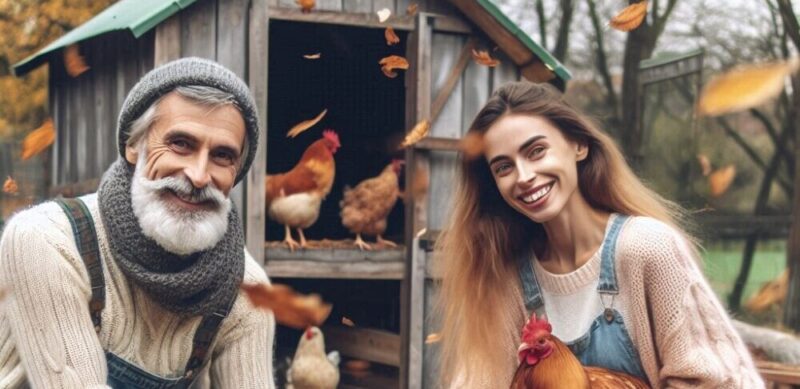
Winter can be tough on your chickens, even tough chickens, and prepping for it isn’t something to overlook. Cold weather brings its own set of challenges, from dropping temperatures to potential moisture buildup. Knowing what you’re up against helps you plan better.
Chickens aren’t too different from us; they feel the cold, too. Even if they can fluff and tighten their feathers to adjust to the heat and the cold, if their environment isn’t prepped right, they can become stressed, and their health might take a hit.
Adequate preparation ensures they remain comfortable and healthy and continue laying eggs even when it’s chilly.
During winter, it’s not just about keeping them warm. Moisture control is another critical area. Too much humidity can lead to respiratory problems or frostbite. Closing up your coop might seem like the way to go, but it can do more harm than good if not done correctly.
Understanding the behavioral changes in chickens during winter is also key. They might eat more to generate body heat, and their activity levels can drop. It’s all about ensuring they have the right environment to stay active and healthy even when it’s freezing outside.
While it helps to choose cold-hardy breeds to begin with, a well built coop allows you to expand on your backyard buddy choices. Maybe you want to get into show birds or exotics. Make your coop good for all.
Preparing and Insulating the Coop Structure
Winterizing your coop begins with a thorough inspection. Check for drafts, gaps, or weak spots where cold air or moisture could seep. Repair any damage to ensure the structure is solid.
You hear a lot about not making your coop too tight. That can be a little confusing, so let me clarify it for you. You don’t want gaps in the floors, walls, or doors. You do want two ventilation ports, vents, holes, whatever you want to call them, in two spots near the roof. These must be screened so critters, especially mink and weasels, can’t get in.
Insulation plays a significant role in maintaining a cozy environment for your chickens. Use straw, hay, or foam boards to insulate the walls. Avoid stuffing it too tightly; proper insulation requires some air to trap heat effectively.
Here’s the thing about foam boards: Chickens will eat them all day long, so they must be covered with wood, tin, or something chicken-proof.
Ventilation is equally crucial. While it might seem like sealing the coop tight is the best move, maintaining airflow prevents humidity buildup, which can lead to frostbite and respiratory issues. Place vents high up to let moist air escape while avoiding cold drafts at the chicken level.
Don’t forget about the roof. Insulation up top prevents heat loss and protects from moisture leaks. A layer of waterproof material can keep your chickens dry and warm. This is where foil-backed foam board will be handy inside the coop on the ceiling.
Lastly, make sure doors and windows close securely. I don’t know why, but people often say, “good ’nuff” when it comes to chicken coop doors. Use weather stripping if needed to seal any gaps. A well-sealed, insulated coop keeps your chickens snug through those cold winter nights.
Flooring and Bedding Solutions for Winter
Choosing the right flooring material is crucial when winter rolls around. Concrete floors can be cold, so adding a layer of wood or rubber mats can provide some insulation and comfort for your flock.
Bedding is another big factor. Straw and hay are traditional choices, but they tend to get damp quickly. Wood shavings are an excellent alternative that stays dry longer and offers better insulation. Some folks swear by sand because it’s easy to clean and doesn’t hold moisture like organic bedding.
I’m a pine shavings fan and an advocate for the deep-litter method through the winter.
The deep litter method is worth considering. This involves adding layers of fresh bedding over the old. The decomposition process generates heat, which helps keep your coop warm. Just make sure to turn the bedding regularly to avoid compacting and to facilitate proper breakdown.
Monitor the bedding condition regularly. Damp bedding can lead to health problems, so replace it when it gets wet or smells like ammonia. Don’t worry; you’ll know when your ammonia level is too high.
One day, you will open the coop door and be hit by the unmistakable smell of an ammonia wave. Then, it’s time to clean the coop!
It’s helpful to have a compost heap near your coop. I use a mini-silo made of wire-welded fencing. It takes minutes to cut and set up, and it works well. I throw everything in there, from garden plants to grass and weeds to coffee grounds to coop litter (NO MEATS!!).
Hoe out your coop and throw some in your garden and the rest in your compost heap.
Fresh, dry bedding added using the deep litter method helps keep the coop environment healthy and comfortable.
Ensuring Chicken Health and Safety During Winter
Proper feeding of chickens during winter is essential. They need extra calories to produce body heat, so increase their food intake slightly. High-energy foods like cracked corn can provide an extra boost.
Also, ensure they have constant access to clean, unfrozen water. To prevent it from freezing, you might need a heated waterer or a water heater base.
Regular health checks are more important than ever during winter. Look out for signs of frostbite, particularly on combs and wattles. If you notice any black spots, it’s time to take action. Applying petroleum jelly can provide a protective barrier against the cold.
Predator activity tends to increase in winter as animals become desperate for food. Ensure your coop is locked up tight every night and check for any signs of attempts to breach it. Hardware cloth is a good option for reinforcing existing barriers.
You can even use electric fencing around your coop if you want an extra layer of defense. It comes in rolls and is very easy to set up and use. Check it out.
Chickens can handle cold weather quite well if the coop is prepared correctly. They’ll manage just fine with proper feeding, insulation, and care even when temperatures drop. It’s all about providing the right environment and keeping an eye on their needs.
How do you snug up your coop when cold weather is coming?
Dave

Chickenmethod.com

